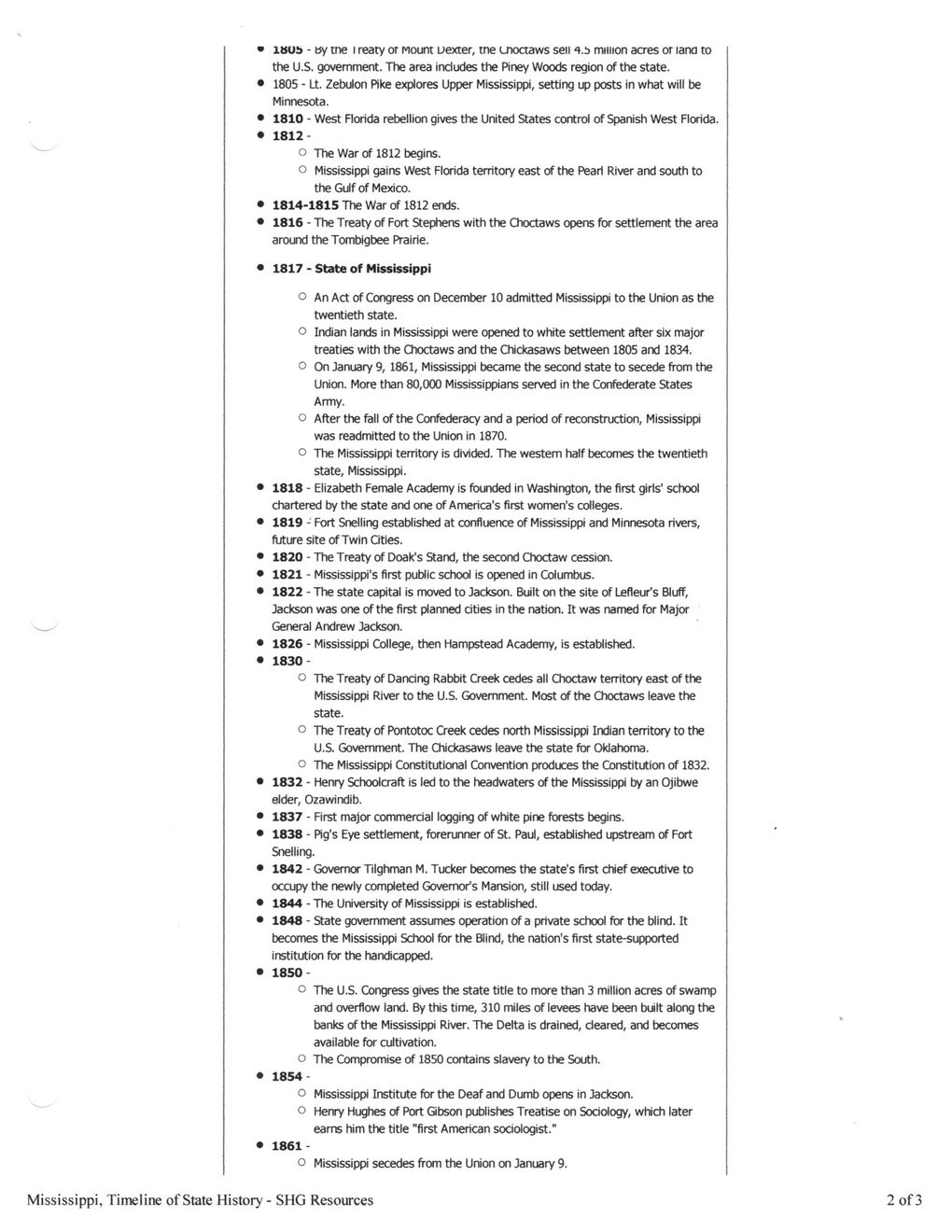This text was obtained via automated optical character recognition.
It has not been edited and may therefore contain several errors.
• mub - tsy tne i reaty or Mount uexter, me uioaaws sen 't.b minion acres or iana to the U.S. government. The area includes the Piney Woods region of the state. • 1805 - Lt. Zebulon Pike explores Upper Mississippi, setting up posts in what will be Minnesota. • 1810 - West Florida rebellion gives the United States control of Spanish West Florida. • 1812- o The War of 1812 begins. o Mississippi gains West Florida territory east of the Peart River and south to the Gulf of Mexico. • 1814-1815 The War of 1812 ends. • 1816 - The Treaty of Fort Stephens with the Choctaws opens for settlement the area around theTombigbee Prairie. • 1817 - State of Mississippi o An Act of Congress on December 10 admitted Mississippi to the Union as the twentieth state. o Indian lands in Mississippi were opened to white settlement after six major treaties with the Choctaws and the Chickasaws between 1805 and 1834. O On January 9, 1861, Mississippi became the second state to secede from the Union. More than 80,000 Mississippians served in the Confederate States Army. o After the fall of the Confederacy and a period of reconstruction, Mississippi was readmitted to the Union in 1870. O The Mississippi territory is divided. The western half becomes the twentieth state, Mississippi. • 1818 - Elizabeth Female Academy is founded in Washington, the first girls' school chartered by the state and one of America's first women's colleges. • 1819 - Fort Snelling established at confluence of Mississippi and Minnesota rivers, future site of Twin Cities. • 1820 - The Treaty of Doak's Stand, the second Choctaw cession. • 1821 - Mississippi's first public school is opened in Columbus. • 1822 - The state capital is moved to Jackson. Built on the site of Lefleur's Bluff, Jackson was one of the first planned cities in the nation. It was named for Major General Andrew Jackson. • 1826 - Mississippi College, then Hampstead Academy, is established. • 1830- O The Treaty of Dancing Rabbit Creek cedes all Choctaw territory east of the Mississippi River to the U.S. Government. Most of the Choctaws leave the state. o The Treaty of Pontotoc Creek cedes north Mississippi Indian territory to the U.S. Government. The Chickasaws leave the state for Oklahoma, o The Mississippi Constitutional Convention produces the Constitution of 1832. • 1832 - Henry Schoolcraft is led to the headwaters of the Mississippi by an Ojibwe elder, Ozawindib. • 1837 - First major commercial logging of white pine forests begins. • 1838 - Pig's Eye settlement, forerunner of St. Paul, established upstream of Fort Snelling. • 1842 - Governor Tilghman M. Tucker becomes the state's first chief executive to occupy the newly completed Governor's Mansion, still used today. • 1844 - The University of Mississippi is established. • 1848 - State government assumes operation of a private school for the blind. It becomes the Mississippi School for the Blind, the nation's first state-supported institution for the handicapped. • 1850- o The U.S. Congress gives the state title to more than 3 million acres of swamp and overflow land. By this time, 310 miles of levees have been built along the banks of the Mississippi River. The Delta is drained, cleared, and becomes available for cultivation. O The Compromise of 1850 contains slavery to the South. • 1854- o Mississippi Institute for the Deaf and Dumb opens in Jackson, o Henry Hughes of Port Gibson publishes Treatise on Sociology, which later earns him the title "first American sociologist." • 1861- O Mississippi secedes from the Union on January 9. Mississippi, Timeline of State History - SHG Resources 2 of 3

Mississippi General Document (002)